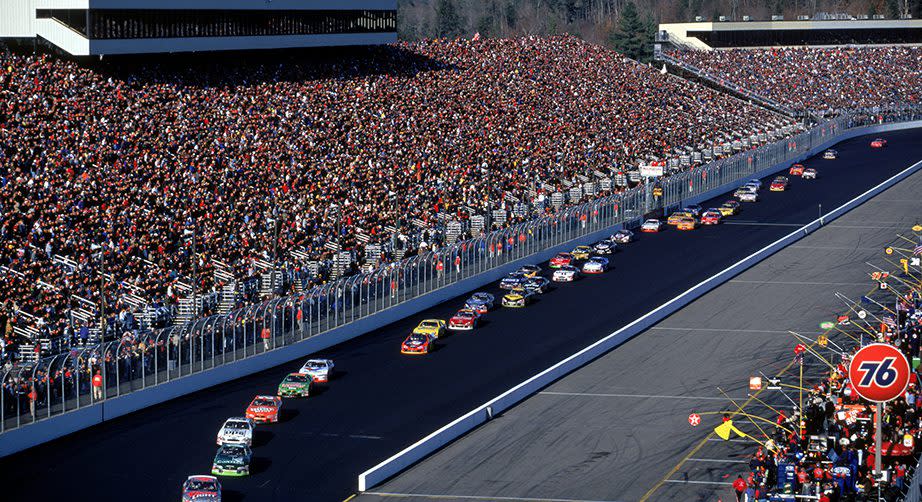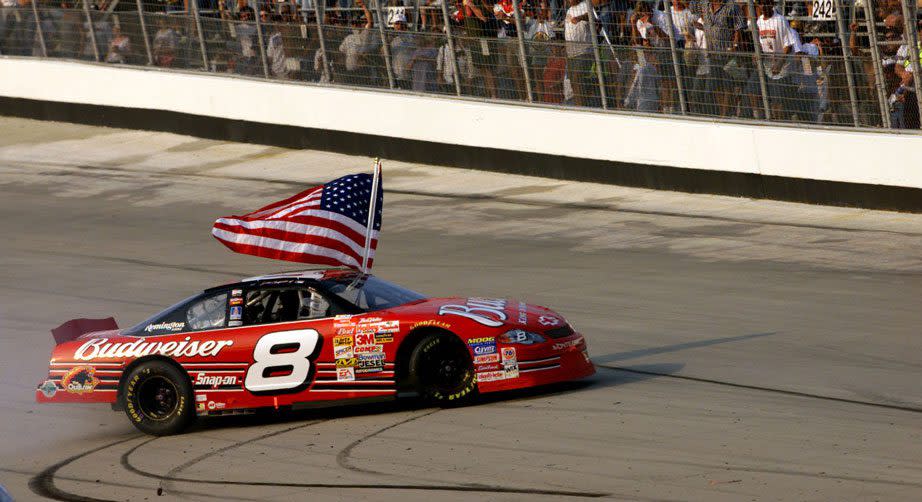From darkness to healing
Mike Helton sat in his Daytona Beach, Florida, office on the morning of September 11, 2001. Like most mornings, three small televisions sat on the wall to the right of his desk — one tuned to news, one to sports and the third to weather.
He was on the phone with an associate in Washington, D.C., that Tuesday, when the voice on the other end said, “Did you see that?” At the time, the earliest news coverage depicted a horrifying accident and not the full details to come of a coordinated terrorist attack. Soon, all three TVs beside Helton’s desk were tuned to the news.
“I’ve tried to try to pinpoint … I think I was just stunned,” Helton said recently, recalling how he grappled with processing what was unfolding. So was the rest of the nation, as was a sport that he guided as NASCAR President.
Helton was soon joined by Bill France Jr., Jim France and other members of the sport’s senior leadership around the TV’s awful glow. The emotions were still raw and overpowering, but as the information trickled in and the gravity of the national crisis started to set in, there was still a sport to run. The next big-league race was just days away and 900 miles north of the Charlotte hub, and all air travel in the country had been suspended.

I think I was just stunned.

“That kind of led us to, OK, this is Tuesday. The industry is going to be at New Hampshire on Thursday,” Helton recalled discussing, “which led to OK, do we have to be there on Thursday. Can we wait and go Saturday? to Do we even need to go at all?, under the circumstances and the magnitude of that. … And if we didn’t, when do we?“
NASCAR soon joined almost all of the sports world in making the difficult decision to postpone its events. Sports has the power to enrich and uplift, even during some of our darkest hours. NASCAR joined the sports world in that, too.
• • •
What stock-car racing had already endured leading up to the 9/11 attacks helps provide context. The sport was undergoing a period of great change — adding a new manufacturer in Dodge, and new broadcast partners with FOX Sports and NBC that year — but also a time of great tragedy.
Kenny Irwin Jr., Adam Petty and Tony Roper had all died in racing crashes the season before, and Dale Earnhardt’s fatal crash in the 2001 Daytona 500 had accelerated a major push toward research and safety developments. The sanctioning body’s report on the full investigation into Earnhardt’s wreck was delivered just 21 days before the attacks.
“Most of our year was spent, we were routinely … hosting race events every weekend, but during the week, there were a lot of people very busy on trying to get those answers that we told the industry that we would get,” Helton says. “So we spent a lot of time and it wasn’t until late August when we went public with the findings. …
“So 2001 was a complicated year, but I think NASCAR and the industry at whole learned a lot from that year that we still apply today and have made a lot of strides in that we’ll never discount that opportunity that 2001 gave us, as tough as it was.”

Safety would be an ongoing focus, but the immediate task at hand for Helton and NASCAR leadership concerned the schedule. Other sports leagues called for postponements, but weekend events coming up in the motorsports world, and in pro and college football were among those in limbo.
The logistics of setting up shop at New Hampshire Motor Speedway while American flights were grounded was increasingly daunting. One team was testing in Kansas, another in Dover when the attacks occurred. A group of officials had gathered for a conference in Richmond. The re-routing and transportation was one issue, but the gut feel of putting on such a diversion in the wake of a national crisis was quite another.
Drivers were divided in their opinions. “It makes me mad,” Jeff Burton, then a Cup Series driver and now an NBC Sports analyst, said back then. “Part of my emotions in this thing is that I want to make sure that the idiots that did this don’t win. With all the pain that they’ve caused, we’ve got to make sure they don’t win and that’s part of me wanting to get back to normalcy. I want to just shove that back into the face of these idiots and show them that we are resilient.”
Others were still staggered by the day’s events. “Normally, I’ll race anywhere, any place at any time,” Tony Stewart told the Associated Press. “But nothing’s been normal since Tuesday morning. I’m still in shock, to be honest, of what has happened, just like everyone else.”
By Wednesday, NASCAR officials had already canceled practice sessions and qualifying for some of the New Hampshire events, setting the starting lineup for that Sunday’s 300-lapper based on car owner standings. Thursday brought the decision to bump the New Hampshire event to November, a move believed to be the second non-weather postponement for NASCAR’s top series to that point. Officials had rescheduled the 1998 running of Daytona’s annual July race to October because of wildfires in central Florida. The next schedule alteration of that type came after the COVID-19 outbreak in March 2020.
Some drivers raised concerns about the schedule shift, reluctant to give up part of their Thanksgiving weekend with family and also bracing for the prospect of racing in chilly New England in late fall (the race date wound up being unseasonably warm in a fortunate bend of fate). But an overriding thought that factored into the decision was the overall emotional state, both of the country and the NASCAR industry.
“I think the overwhelming consensus on everybody’s side — and we got this from our industry, the garage area — that the magnitude of this event, I just don’t have the energy to go do this,” says Helton, acknowledging the dialogue with stakeholders on both sides of the debate. “I think we kind of, by the end of the day and then officially on Wednesday came to the consensus that, well … let’s focus. Let’s heal, and be respectful of what all happened on 9/11, and then we’ll figure out what’s next.”
• • •
Enter Parallax Text
What happened next was an outpouring of charitable acts from drivers, teams and sponsors. Dover International Speedway, host to the next race on the schedule, worked with the American Red Cross to donate more than $100,000 to relief efforts. Teams contributed portions of the race purse to charity, and drivers set up auctions of race-worn items.
“Going back to Dover, there were a lot of internal stories about people who knew people that were impacted by what had happened,” Helton says. “And that’s a catalyst of its own to I think our industry in particular, and part of the reason I’m so proud to be part of it is that it organically follows the climate or the temperature or the reaction that I think America has to things like this.
“And so once we decided we were going to go back to Dover, then the teams organically just began to say, ‘well, this is what I’m going to do, you know. This is what we’re going to do to pay tribute to what happened, and pay tribute to the American spirit.’ So you had this overwhelming in the garage area, from car designs to uniforms to different things in a very quick order.”
Paint schemes for the MBNA Cal Ripken Jr. 400 took on a patriotic feel, with diecast sales from those special designs earmarked for disaster relief. Pageantry ran high in pre-race, from the music to the more solemn moments of remembrance. But one final touch capped it off.
Days earlier, track CEO Denis McGlynn had anticipated having a full house for the first race back. But he wanted to give an American flag to each fan as they passed through the Monster Mile’s gates — a number that reached the tens of thousands.

“I said, if you can find them, I said we’re all for it,” Helton said. The fans saluted the drivers and teams, waving Old Glory as the green flag unfurled in unison to start the race.
Eventual race winner Dale Earnhardt Jr. credited the red, white and blue display as a ready-made inspiration for his victory celebration — an iconic, smoky burnout with an American flag flapping in the breeze. “I did it to show the fans that I put my pants on the same way they do and I have the same feelings they have been having over the last two weeks. The fact that we were here racing this week, I think it helped in the healing process.”
Earnhardt Jr. was among the first to reveal a commemorative paint scheme for the JR Motorsports entry he’ll race in the NASCAR Xfinity Series this weekend at Richmond Raceway. Other teams, drivers and sponsors have followed suit with other ways of marking the 20th anniversary of the event.
RELATED: See paint schemes for this weekend at Richmond
Helton says it’s hard to believe that 20 years have passed, but noted that he’s found meaning in all the heartfelt remembrances during previous milestones. That’s what he hopes for again this weekend at Richmond.
“I think it’s important for us to resurrect that tribute, and be very meaningful around reminding all of us that that was a very tragic, heartbreaking moment,” Helton says, “and we should never forget it, and we shouldn’t forget the ones that suffered that day.”

